ASUS PRO60VA, Z92V User Manual

Notebook PC
Hardware User’s Manual
E2239 / Aug 2005

Safety Statements



 Federal Communications Commission Statement
Federal Communications Commission Statement
This device complies with FCC Rules Part 15. Operation is subject to the following two conditions:
•This device may not cause harmful interference, and
•This device must accept any interference received, including interference that may cause undesired operation.
This equipment has been tested and found to comply with the limits for a class B digital device, pursuant to Part 15 of the Federal Communications Commission (FCC) rules. These limits are designed to provide reasonable protection against harmful interference in a residential installation. This equipment generates, uses, and can radiate radio frequency energy and, if not installed and used in accordance with the instructions, may cause harmful interference to radio communications. However, there is no guarantee that interference will not occur in a particular installation. If this equipment does cause harmful interference to radio or television reception, which can be determined by turning the equipment off and on, the user is encouraged to try to correct the interference by one or more of the following measures:
•Reorient or relocate the receiving antenna.
•Increase the separation between the equipment and receiver.
•Connect the equipment into an outlet on a circuit different from that to which the receiver is connected.
•Consult the dealer or an experienced radio/TV technician for help.
WARNING! The use of a shielded-type power cord is required in order to meet FCC emission limits and to prevent interference to the nearby radio and television reception. It is essential that only the supplied power cord be used. Use only shielded cables to connect I/O devices to this equipment. You are cautioned that changes or modifications not expressly approved by the party responsible for compliance could void your authority to operate the equipment.
(Reprinted from the Code of Federal Regulations #47, part 15.193, 1993. Washington DC: Office of the Federal Register, National Archives and Records Administration, U.S. Government Printing Office.)
Canadian Department of Communications Statement
This digital apparatus does not exceed the Class B limits for radio noise emissions from digital apparatus set out in the Radio Interference Regulations of the Canadian Department of Communications.
This Class B digital apparatus complies with Canadian ICES-003.
(Cet appareil numérique de la classe B est conforme à la norme NMB-003 du Canada.)
CE Mark Warning
This is a Class B product, in a domestic environment, this product may cause radio interference, in which case the user may be required to take adequate measures.
2
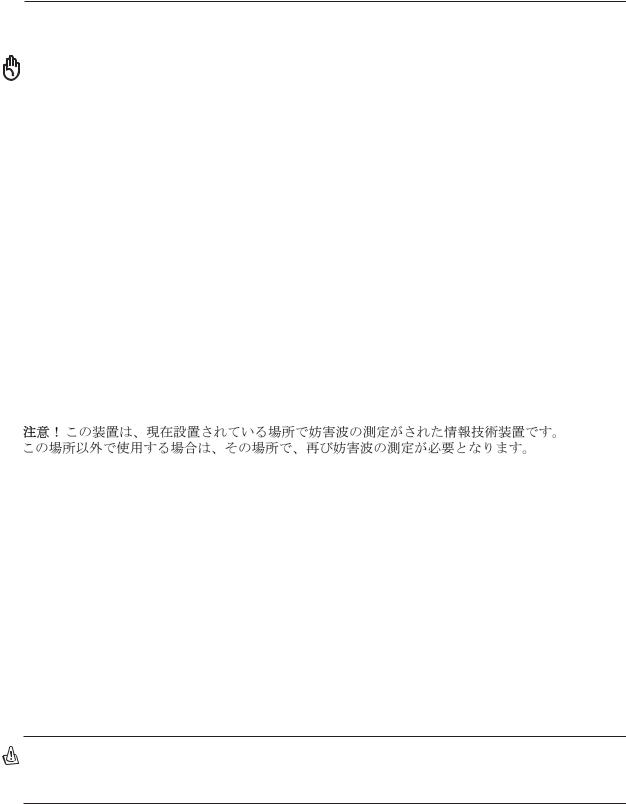
Safety Statements
Nordic Cautions (for Notebook PC with Lithium-Ion Battery)
CAUTION! Danger of explosion if battery is incorrectly replaced. Replace only with the same or equivalent type recommended by the manufacturer. Dispose of used batteries according to the manufacturer’s instructions. (English)
ATTENZIONE! Rischio di esplosione della batteria se sostituita in modo errato. Sostituire la batteria con un una di tipo uguale o equivalente consigliata dalla fabbrica. Non disperdere le batterie nell’ambiente. (Italian)
VORSICHT! Explosionsgetahr bei unsachgemäßen Austausch der Batterie. Ersatz nur durch denselben oder einem vom Hersteller empfohlenem ähnlichen Typ. Entsorgung gebrauchter Batterien nach Angaben des Herstellers. (German)
ADVARSELI! Lithiumbatteri - Eksplosionsfare ved fejlagtig håndtering. Udskiftning må kun ske med batteri af samme fabrikat og type. Levér det brugte batteri tilbage til leverandøren. (Danish)
VARNING! Explosionsfara vid felaktigt batteribyte. Använd samma batterityp eller en ekvivalent typ som rekommenderas av apparattillverkaren. Kassera använt batteri enligt fabrikantens instruktion. (Swedish)
VAROITUS! Paristo voi räjähtää, jos se on virheellisesti asennettu. Vaihda paristo ainoastaan laitevalmistajan sousittelemaan tyyppiin. Hävitä käytetty paristo valmistagan ohjeiden mukaisesti. (Finnish)
ATTENTION! Il y a danger d’explosion s’il y a remplacement incorrect de la batterie. Remplacer uniquement avec une batterie du mêre type ou d’un type équivalent recommandé par le constructeur. Mettre au rebut les batteries usagées conformément aux instructions du fabricant. (French)
ADVARSEL! Eksplosjonsfare ved feilaktig skifte av batteri. Benytt samme batteritype eller en tilsvarende type anbefalt av apparatfabrikanten. Brukte batterier kasseres i henhold til fabrikantens instruksjoner. (Norwegian)
(Japanese)
Macrovision Corporation Product Notice
This product incorporates copyright protection technology that is protected by method claims of certain U.S.A. patents and other intellectual property rights owned by Macrovision Corporation and other rights owners. Use of this copyright protection technology must be authorized by Macrovision Corporation, and is intended for home and other limited viewing uses only unless otherwise authorized by Macrovision Corporation. Reverse engineering or disassembly is prohibited.
CDRH Regulations
The Center for Devices and Radiological Health (CDRH) of the U.S. Food and Drug Administration implemented regulations for laser products on August 2, 1976. These regulations apply to laser products manufactured from August 1, 1976. Compliance is mandatory for products marketed in the United States.
WARNING: Use of controls or adjustments or performance of procedures other than those specified herein or in the laser product installation guide may result in hazardous radiation exposure.
3
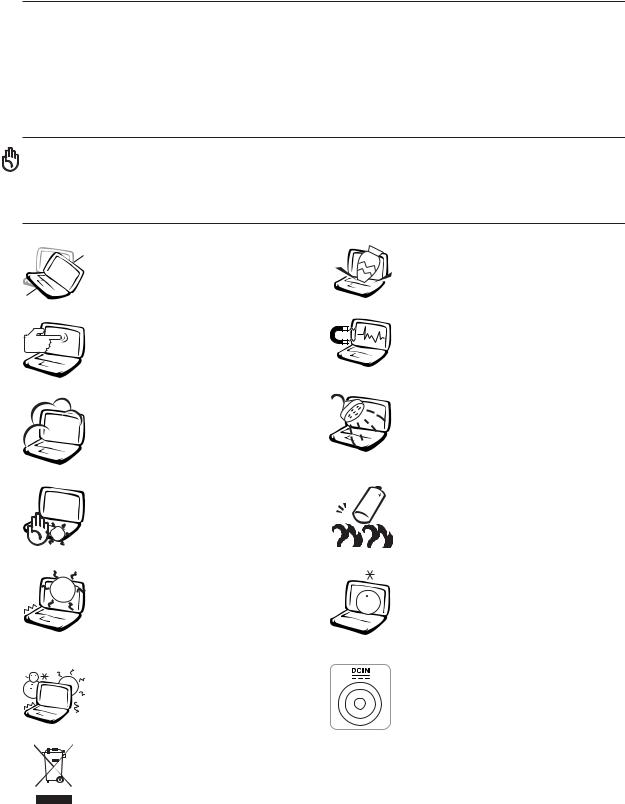
Safety Statements
Safety Precautions
The following safety precautions will increase the life of the Notebook PC. Follow all precautions and instructions. Except as described in this manual, refer all servicing to qualified personnel. Do not use damaged power cords, accessories, or other peripherals. Do not use strong solvents such as thinners, benzene, or other chemicals on or near the surface.
Disconnect the AC power and remove the battery pack(s) before cleaning. Wipe the Notebook PC using a clean cellulose sponge or chamois cloth dampened with a solution of nonabrasive detergent and a few drops of warm water and remove any extra moisture with a dry cloth.
DO NOT place on uneven or unstable work surfaces. Seek servicing if the casing has been damaged.
DO NOT press or touch the display panel. Do not place together with small items that may scratch or enter the Notebook PC.
DO NOT expose to dirty or dusty environments. DO NOT operate during a gas leak.
DO NOT leave the Notebook PC on your lap or any part of the body while the Notebook PC is turned ON or is charging in order to prevent discomfort or injury from heat exposure.
DONOTexposetoextremetemperatures  above 50˚C (122˚F) or to direct sunlight.
above 50˚C (122˚F) or to direct sunlight. 
 Do not block the fan vents!
Do not block the fan vents! 
SAFE TEMP: This notebook PC should only be used in environments with ambient temperatures between 0°C (32°F) and 35°C (95°F).
DO NOT place or drop objects on top and do not shove any foreign objects into the Notebook PC.
DO NOT expose to strong magnetic or electrical fields.
DO NOT expose to or use near liquids, rain, or moisture. DO NOT use the modem during an electrical storm.
DO NOT throw batteries in fires as they may explode. Check local codes for special battery disposal instructions.
DO NOT expose to extreme temperatures (below 0˚C (32˚F), otherwise the Notebook PC may not boot.
INPUT RATING: Must only receive power input of 19VDC, 3.42A (65W).
The symbol of the crossed out wheeled bin indicates that the product (electrical and electronic equipment) should not be placed in municipal waste. Please check local regulations for disposal of electronic products.
4
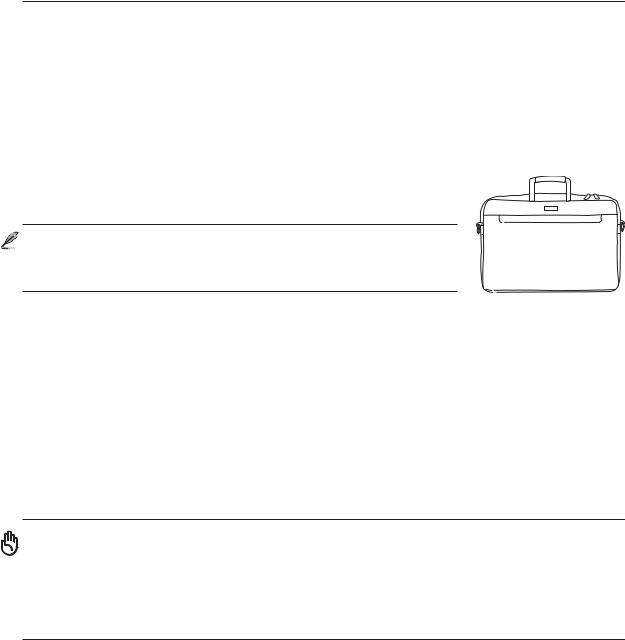
Safety Statements
Transportation Precautions
To prepare the Notebook PC for transport, you should turn it OFF and disconnect all external peripherals to prevent damage to the connectors. The hard disk drive’s head retracts when the power is turned OFF to prevent scratching of the hard disk surface during transport. Therefore, you should not transport the Notebook PC while the power is still ON. Close the display panel and check that it is latched securely in the closed position to protect the keyboard and display panel.
Cover Your Notebook PC
Purchase an optional carrying case to protect your Notebook PC from dirt, water, shock, and scratches.
NOTE: The surface glaze is easily dulled if not properly cared for. Be careful not to rub or scrap the Notebook PC surfaces when transporting your Notebook PC.
Charge Your Batteries
If you intend to use battery power, be sure to fully charge your battery pack and any optional battery packs before going on long trips. Remember that the power adapter charges the battery pack as long as it is plugged into the computer and an AC power source. Be aware that it takes much longer to charge the battery pack when the Notebook PC is in use.
Airplane Precautions
Contact your airline if you want to use the Notebook PC on the airplane. Most airlines will have restrictions for using electronic devices. Most airlines will allow electronic use only between and not during takeoffs and landings.
CAUTION! There are three main types of airport security devices: X-ray machines (used on items placed on conveyor belts), magnetic detectors (used on people walking through security checks), and magnetic wands (hand-held devices used on people or individual items). You can send your Notebook PC and diskettes through airport X- ray machines. However, it is recommended that you do not send your Notebook PC or diskettes through airport magnetic detectors or expose them to magnetic wands.
5
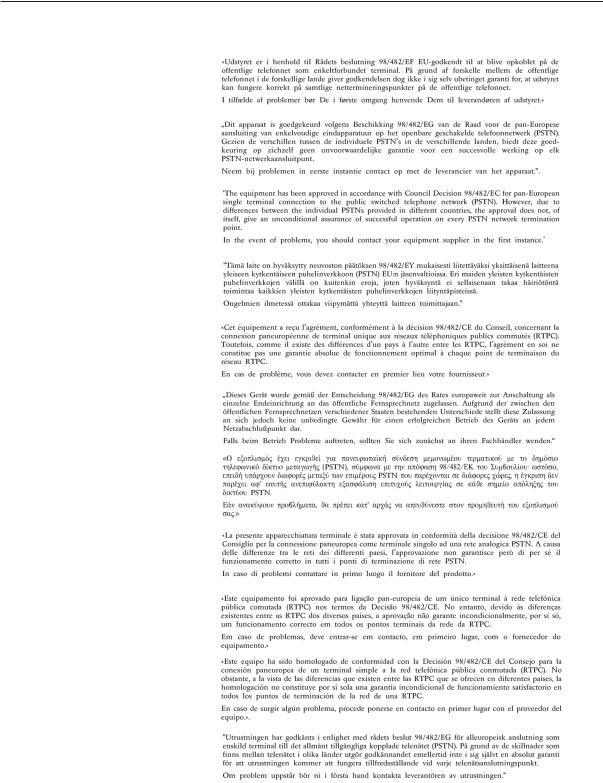
Safety Statements
CTR 21 Approval (for Notebook PC with built-in Modem)
Danish
Dutch
English
Finnish
French
German
Greek
Italian
Portuguese
Spanish
Swedish
6

Safety Statements
 UL Safety Notices
UL Safety Notices
Required for UL 1459 covering telecommunications (telephone) equipment intended to be electrically connected to a telecommunication network that has an operating voltage to ground that does not exceed 200V peak, 300V peak-to-peak, and 105V rms, and installed or used in accordance with the National Electrical Code (NFPA 70).
When using the Notebook PC modem, basic safety precautions should always be followed to reduce the risk of fire, electric shock, and injury to persons, including the following:
•Do not use the Notebook PC near water, for example, near a bath tub, wash bowl, kitchen sink or laundry tub, in a wet basement or near a swimming pool.
•Do not use the Notebook PC during an electrical storm. There may be a remote risk of electric shock from lightning.
•Do not use the Notebook PC in the vicinity of a gas leak.
Required for UL 1642 covering primary (nonrechargeable) and secondary (rechargeable) lithium batteries for use as power sources in products. These batteries contain metallic lithium, or a lithium alloy, or a lithium ion, and may consist of a single electrochemical cell or two or more cells connected in series, parallel, or both, that convert chemical energy into electrical energy by an irreversible or reversible chemical reaction.
•Do not dispose the Notebook PC battery pack in a fire, as they may explode. Check with local codes for possible special disposal instructions to reduce the risk of injury to persons due to fire or explosion.
•Do not use power adapters or batteries from other devices to reduce the risk of injury to persons due to fire or explosion. Use only UL certified power adapters or batteries supplied by the manufacturer or authorized retailers.
Notebook PC Optical Drive
Laser Safety Information
Internal or external optical drives sold with this Notebook PC contains a CLASS 1 LASER PRODUCT (LASER KLASSE 1 PRODUKT). Laser classifications can be found in the glossary at the end of this user’s manual.
WARNING: Making adjustments or performing procedures other than those specified in the user’s manual may result in hazardous laser exposure. Do not attempt to disassemble the optical drive. For your safety, have the optical drive serviced only by an authorized service provider.
Service warning label
CAUTION: INVISIBLE LASER RADIATION WHEN OPEN. DO NOT STARE INTO BEAM OR VIEW DIRECTLY WITH OPTICAL INSTRUMENTS.
7

Contents |
|
1. Introducing the Notebook PC ................................................................ |
11 |
About This User’s Manual ..................................................................................................... |
12 |
Notes For This Manual ..................................................................................................... |
12 |
Preparing your Notebook PC ................................................................................................ |
13 |
2. Knowing the Parts.................................................................................. |
15 |
Top Side ................................................................................................................................ |
16 |
Bottom Side........................................................................................................................... |
18 |
Right Side.............................................................................................................................. |
20 |
Left Side ................................................................................................................................ |
22 |
Front Side.............................................................................................................................. |
23 |
Rear Side .............................................................................................................................. |
24 |
3. Getting Started ....................................................................................... |
25 |
Using the Battery Pack.......................................................................................................... |
26 |
Installing and Removing the Battery Pack ....................................................................... |
26 |
Charging the Battery Pack ............................................................................................... |
27 |
Battery Care ..................................................................................................................... |
27 |
Operating Systems................................................................................................................ |
27 |
Support Software ............................................................................................................. |
27 |
Power Connection ................................................................................................................. |
28 |
Powering ON The Notebook PC ...................................................................................... |
29 |
The Power-On Self Test (POST) ...................................................................................... |
29 |
Power Management - “Stand By” & “Hibernate” .............................................................. |
30 |
Restarting or Rebooting ................................................................................................... |
31 |
Powering OFF the Notebook PC ..................................................................................... |
32 |
Using the Keyboard............................................................................................................... |
33 |
Colored Hot Keys ............................................................................................................. |
33 |
Microsoft Windows™ Keys .............................................................................................. |
34 |
Keyboard as a Numeric Keypad ...................................................................................... |
35 |
Keyboard as Cursors ....................................................................................................... |
35 |
Instant Launch Keys and Status Indicators ........................................................................... |
36 |
Instant Launch Keys ........................................................................................................ |
36 |
Status Indicators (front edge) ........................................................................................... |
37 |
Status Indicators (above keyboard) ................................................................................. |
38 |
CD Player Control Buttons and Indicator ......................................................................... |
38 |
4. Using the Notebook PC ......................................................................... |
41 |
Pointing Device ..................................................................................................................... |
42 |
Using the Touchpad ......................................................................................................... |
42 |
Touchpad Usage Illustrations ........................................................................................... |
43 |
8

|
Contents |
Caring for the Touchpad ................................................................................................... |
44 |
Storage Devices .................................................................................................................... |
45 |
PC Card (PCMCIA) Socket .............................................................................................. |
45 |
Optical Drive .................................................................................................................... |
47 |
Flash Memory Card Reader ............................................................................................. |
49 |
Hard Disk Drive ................................................................................................................ |
50 |
Modem and Network Connections ........................................................................................ |
50 |
Modem Connection .......................................................................................................... |
53 |
Network Connection ......................................................................................................... |
53 |
Bluetooth Wireless Connection (on selected models) ..................................................... |
54 |
Power System ....................................................................................................................... |
55 |
AC Power System ............................................................................................................ |
55 |
Battery Power System ..................................................................................................... |
55 |
Power Management Modes ............................................................................................. |
57 |
Appendix ..................................................................................................... |
59 |
Optional Accessories............................................................................................................. |
60 |
USB Hub (Optional) ......................................................................................................... |
60 |
USB 2.0 Slim Combo Drive (Optional) ............................................................................. |
60 |
Wireless LAN Cardbus Card or USB ............................................................................... |
61 |
USB Flash Memory Disk .................................................................................................. |
61 |
USB Communication Cable ............................................................................................. |
61 |
USB Floppy Disk Drive .................................................................................................... |
62 |
USB Keyboard and Mouse .............................................................................................. |
62 |
Optional Connections ............................................................................................................ |
63 |
Monitor Out Connection ................................................................................................... |
63 |
External Audio Connections ............................................................................................. |
63 |
Securing Your Notebook PC ............................................................................................ |
64 |
IEEE1394 (on selected models) ...................................................................................... |
64 |
Printer Connection ........................................................................................................... |
64 |
DVD-ROM Drive Information................................................................................................. |
65 |
Glossary ................................................................................................................................ |
66 |
Declarations and Safety Statements ..................................................................................... |
70 |
DVD-ROM Drive Information ........................................................................................... |
70 |
Internal Modem Compliancy ............................................................................................ |
73 |
FCC Radio Frequency Interference Requirements .......................................................... |
74 |
FCC RF Exposure Guidelines (Wireless Clients) ............................................................ |
74 |
FCC Radio Frequency Exposure Caution Statement ...................................................... |
74 |
Declaration of Conformity (R&TTE directive 1999/5/EC) ................................................. |
74 |
Wireless Operation Channel for Different Domains ......................................................... |
75 |
France Restricted Wireless Frequency Bands ................................................................. |
75 |
Notebook PC Information ...................................................................................................... |
76 |
9
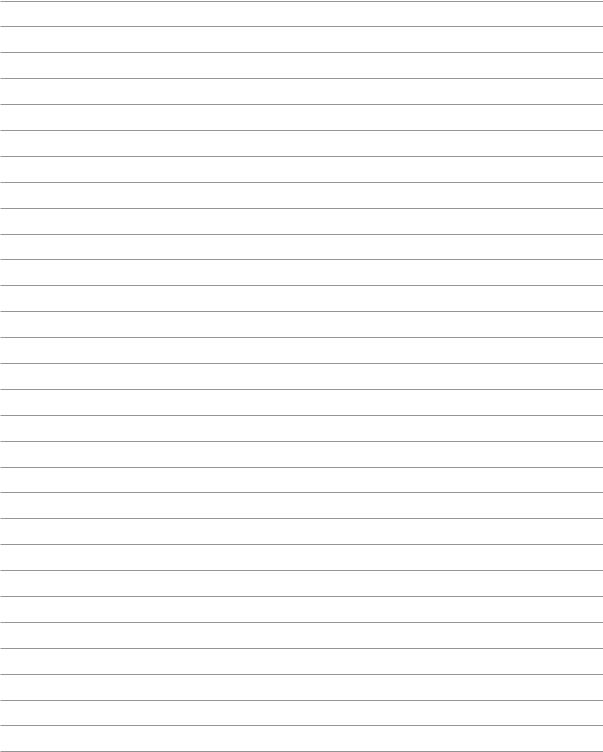
10
1. Introducing the Notebook PC
About This User’s Manual
Notes For This Manual
Preparing your Notebook PC
11
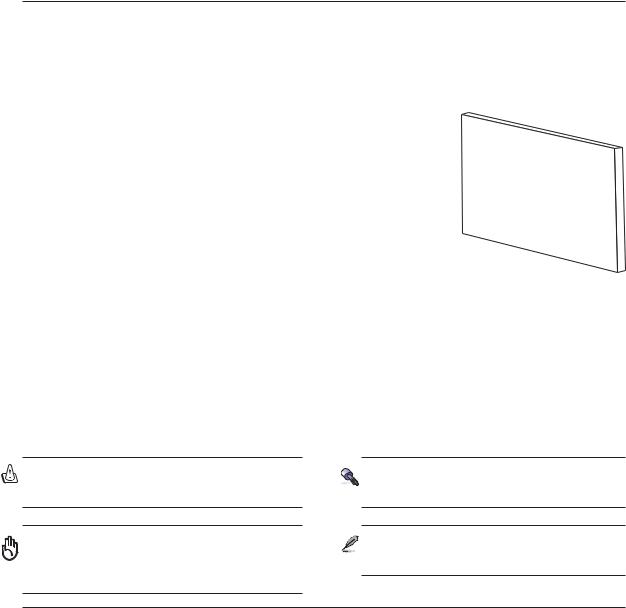
1 Introducing the Notebook PC
About This User’s Manual
You are reading the Notebook PC User’s Manual. This User’s Manual provides information on the various components in the Notebook PC and how to use them. The following are major sections of this User’s Manual:
1.Introducing the Notebook PC
Introduces the Notebook PC and this User’s Manual.
2.Knowing the Parts
Gives information on the Notebook PC components.
3.Getting Started
Provides information on getting started with the Notebook PC.
4.Using the Notebook PC
Gives information on using the Notebook PC’s components.
5.Appendix
Introduces optional accessories, computer terms, and safety information.
User’s |
Manual |
|
Notes For This Manual
A few notes and warnings in bold are used throughout this guide that you should be aware of in order to complete certain tasks safely and completely. These notes have different degrees of importance as described below:
WARNING! Important information that must be followed for safe operation.
IMPORTANT! Vital information that must be followed to prevent damage to data, components, or persons.
TIP: Tips and useful information for completing tasks.
NOTE: Tips and information for special situations.
< > |
Text enclosed in < > or [ ] represents a key on the keyboard; do not actually type the < |
[ ] |
> or [ ] and the enclosed letters. |
|
|
12
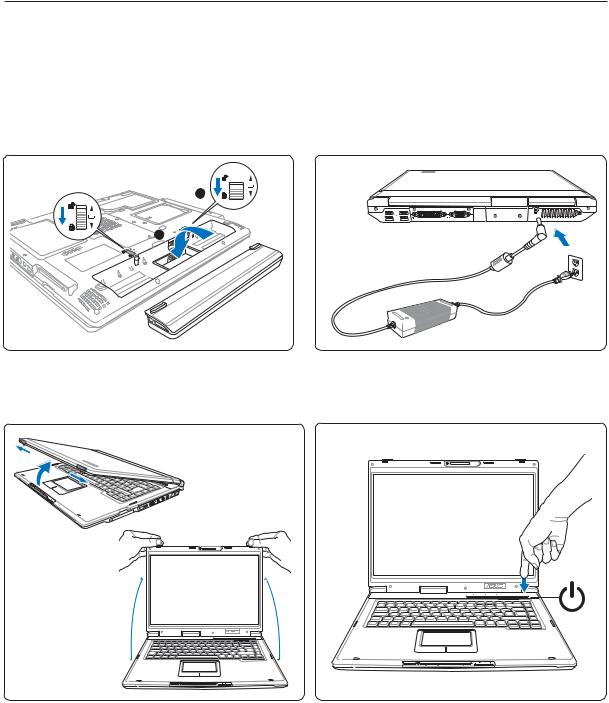
Introducing the Notebook PC 1
Preparing your Notebook PC
These are only quick instructions for using your Notebook PC. Read the later pages for detailed information on using your Notebook PC.
1. Install the battery pack |
2. Connect the AC Power Adapter |
Auto |
|
2 |
Lock |
|
|
|
1 |
[3] |
|
|
[2]
 [1]
[1]
3. Open the Display Panel |
4. Turn ON the Notebook PC |
[1]
[2] [2]
(1)Slide both display panel release latches outwards.
(2)Lift the display panel with both hands while holding both display panel release latches.
Press the power button and release.
(In Windows XP, this button can also be used to safely turn OFF the Notebook PC.)
13
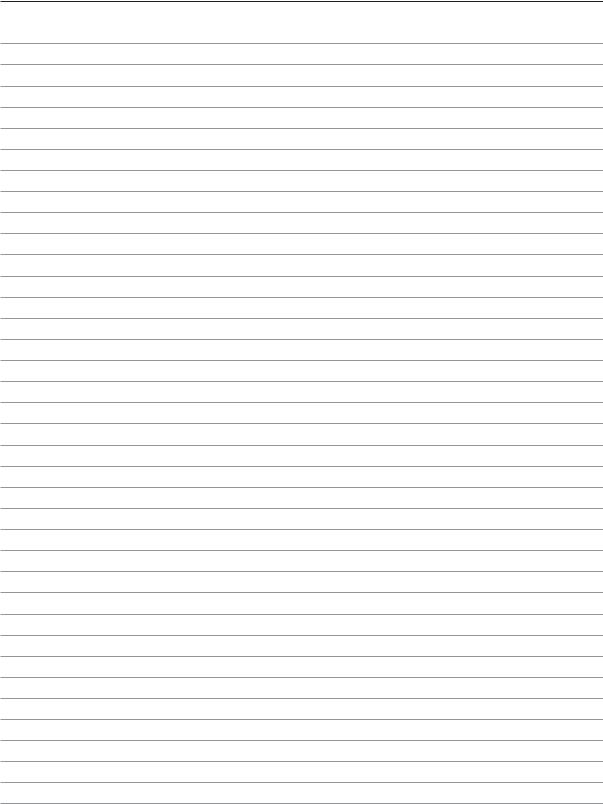
1 Introducing the Notebook PC
14
2. Knowing the Parts
Top Side
Bottom Side
Right Side
Left Side
Front Side
Rear Side
15
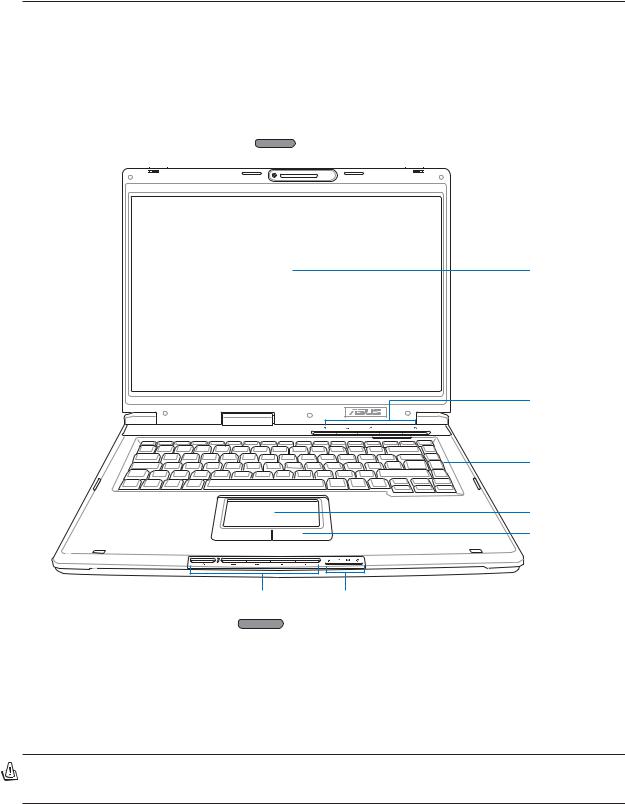
2 Knowing the Parts
Top Side
Refer to the diagram below to identify the components on this side of the Notebook PC. Details are given starting from the top and going clockwise.
Camera
Display Panel Latch |
On selected models Microphone |
Display Panel Latch |
||||||||
|
|
|
|
|
|
|
|
|
|
|
|
|
|
|
|
|
|
|
|
|
|
|
|
|
|
|
|
|
|
|
|
|
|
|
|
|
|
|
|
|
|
|
|
Display Panel
Instant Keys
Power Switch
Keyboard
Touchpad
Touchpad Buttons
CD Control Buttons |
Status Indicators |
(see section 3) |
(see section 3) |
On selected models |
|
 Display Panel Latches
Display Panel Latches
Two spring-loaded latches on the front of the Notebook PC lock the display panel in the closed position when the Notebook PC is not in use. To open the display panel, slide both latches outwards with your thumbs and lift up the display panel with both thumbs. Slowly tilt the display panel forward or backward to a comfortable viewing angle.
WARNING! When opening, do not force the display panel down to the table or else the hinges may break! Never lift the Notebook PC by the display panel!
16

Knowing the Parts 2
 Camera (on selected models)
Camera (on selected models)
The built-in camera allows picture taking or video recording. Can be used with video conferencing and other interactive applications.
 Microphone (built-in)
Microphone (built-in)
The built-in mono microphone can be used for video conferencing, voice narrations, or simple audio recordings.
 Display Panel
Display Panel
The display panel functions the same as a desktop monitor. The Notebook PC uses an active matrix TFT LCD, which provides excellent viewing like that of desktop monitors. Unlike desktop monitors, the LCD panel does not produce any radiation or flickering, so it is easier on the eyes.
 Instant Launch Keys
Instant Launch Keys
Instant launch keys allow you to launch frequently used applications with one push of a button. Details provided later in this manual.
 Power Switch
Power Switch
The power switch allows powering ON and OFF the Notebook PC and recovering from STD. Push the switch once to turn ON and once to turn OFF the Notebook PC.


 Keyboard
Keyboard
The keyboard provides full-sized keys with comfortable travel (depth at which the keys can be depressed) and palm rest for both hands. Two Windows™ function keys are provided to help ease navigation in the Windows™ operating system.
Touchpad and Buttons
The touchpad with its buttons is a pointing device that provides the same functions as a desktop mouse. A software-controlled scrolling function is available after setting up the included touchpad utility to allow easy Windows or web navigation.
 CD Control Buttons (on selected models)
CD Control Buttons (on selected models)
See Section 3 for details.
 Status Indicators
Status Indicators
See Section 3 for details..
17
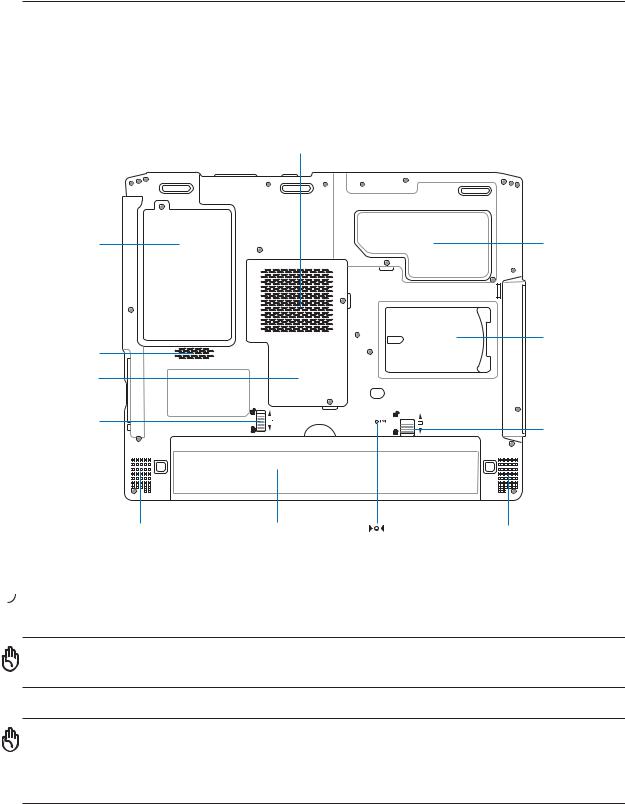
2 Knowing the Parts
Bottom Side
Refer to the diagram below to identify the components on this side of the Notebook PC. Details are given starting from the top and going clockwise.
(Air Vents)
Hard Disk Drive |
CPU |
Compartment |
Compartment |
Name Card
Holder
(Air Vents)
Mini-PCI and
Memory
Compartment
Battery Lock 2
Battery Lock 1
Audio Speaker |
Battery Pack |
Shutdown |
Audio Speaker |
|
|
Button |
|
 Air Vents
Air Vents
The air vents allow cool air to enter and warm air to exit the Notebook PC.
IMPORTANT! Make sure that paper, books, clothing, cables, or other objects do not block any of the air vents or else overheating of the Notebook PC may occur.
IMPORTANT! The bottom of the Notebook PC can get very hot. Be careful when handling the Notebook PC while it is in operation or recently been in operation. High temperatures are normal during charging or operation. DO NOT PUT THE NOTEBOOK PC ON THE LAP OR OTHER PARTS OF THE BODY TO AVOID INJURY FROM THE HEAT.
18
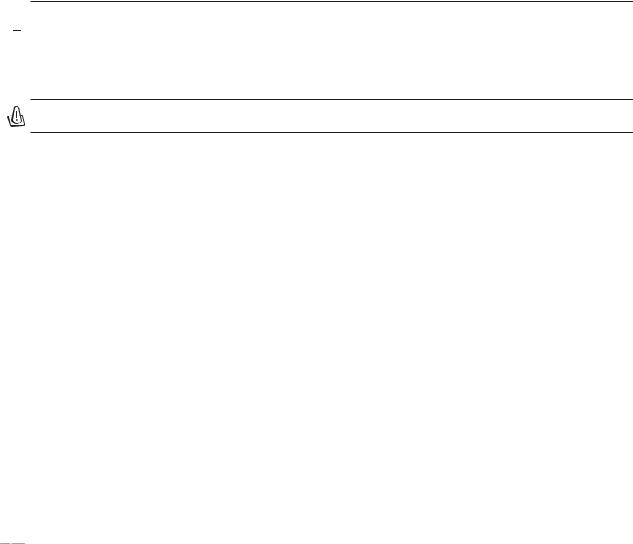
Knowing the Parts 2
 Central Processor (CPU)
Central Processor (CPU)
Some Notebook PC models feature a socketed-processor design to allow upgrading to faster processors in the future. Some models feature a ULV design for compactness and may not be upgraded. Visit an authorized service center or retailer for information on upgrades.
WARNING! End-user removal of the CPU or hard disk drive will void the warranty.
 Battery Lock
Battery Lock
The spring loaded latch (lock 1) automatically locks the battery pack when inserted but must be reinforced with a manually operated latch (lock 2). Usage details are described in the battery section later in this manual.
 Battery Pack
Battery Pack
The battery pack is actually combined with the Notebook PC’s surface in order to reduce thickness. When the battery is released, the surface and battery pack will be seen as a single unit. The battery pack cannot be further disassembled and must be replaced as a single unit.

 Audio Speakers
Audio Speakers
The built-in speaker allows you to hear audio without additional attachments. The multimedia sound system features an integrated digital audio controller that produces rich, vibrant sound (results improved with external stereo headphones or speakers). All audio features are software controlled.
 Mini-PCI Compartment
Mini-PCI Compartment
Optional expansion cards can be installed in the mini-PCI compartment. An optional wireless LAN module enables you to stay connected to your LAN while “roaming” to meeting, conference rooms, or other office locations. Full-time, real-time access to email, Internet, and network resources means not only an expanded office space, but also greater productivity.



 Memory (RAM) Compartment
Memory (RAM) Compartment
The memory compartment contains one or two (depending on model) expansion slots for additional memory. Additional memory will increase application performance by decreasing hard disk access. The BIOS automatically detects the amount of memory in the system and configures CMOS accordingly during the POST (Power-On-Self-Test) process. There is no hardware or software (including BIOS) setup required after the memory is installed. Visit an authorized service center or retailer for information on memory upgrades for your Notebook PC. Only purchase expansion modules from authorized retailers of this Notebook PC to ensure maximum compatibility and reliability.
 Hard Disk Drive Compartment
Hard Disk Drive Compartment
The hard disk drive is secured in a compartment. Hard disk drive upgrades are to be done by authorized service centers or dealers only.
19
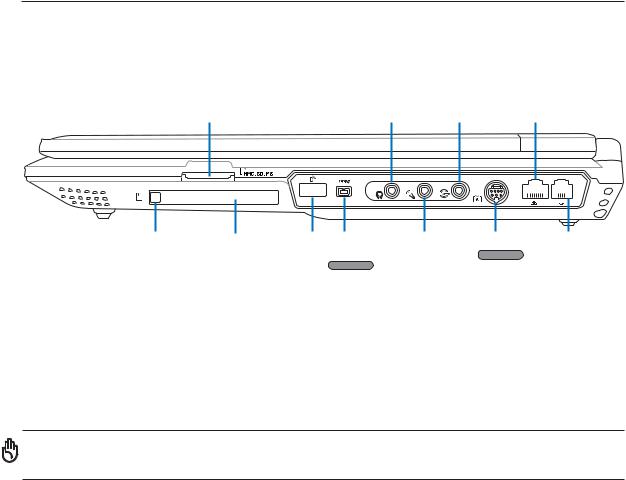
2 Knowing the Parts
Right Side
Refer to the diagram below to identify the components on this side of the Notebook PC.
Flash Memory |
Phone |
Audio |
LAN |
Slot |
Output |
Input |
Port |
PC Card |
PC Card |
Infrared |
1394 |
Mic |
TV Out |
Modem |
Eject |
Slot |
Port |
Port |
Input |
On selected models |
Port |
|
|
|
On selected models |
|
|
|
Flash Memory Slot
Normally a PCMCIA or USB memory card reader must be purchased separately in order to use memory cards from devices such as digital cameras, MP3 players, mobile phones, and PDAs. This Notebook PC has a built-in memory card reader that can read many flash memory cards as specified later in this manual. The built-in memory card reader is not only convenient, but also faster than most other forms of memory card readers because it utilizes the high-bandwidth PCI bus. More information is provided in section 4 of this manual.
IMPORTANT! Never remove cards while or immediately after reading, copying, formatting, or deleting data on the card or else data loss may occur.

 TV-Out Port (on selected models)
TV-Out Port (on selected models)
The TV-Out port is an S-Video connector that allows routing the Notebook PC’s display to a television or video projection device. You can choose between simultaneously or single display. Use an S-Video cable (not provided) for high quality displays or use the provided RCA to S-Video adapter for standard video devices. This port supports both NTSC and PAL formats.
 PC Card Slot
PC Card Slot
One PCMCIA 2.1 compliant PC Card socket is available to support one type I/II PC card. The socket supports 32-bit CardBus. This allows accommodation of Notebook PC expansion options such as memory cards, ISDN, SCSI, Smart Cards, and wireless network adapters.
 Infrared Port (Standard Infrared)
Infrared Port (Standard Infrared)
The standard infrared (IrDA) communication port allows convenient wireless data communication with infrared-equipped devices or computers. This allows easy wireless synchronization with PDAs or mobile phones and even wireless printing. If your office supports IrDA networking, you can have wireless connection to a network anywhere provided there is a direct line of sight to an IrDA node.
20

Knowing the Parts 2

 1394 Port (on selected models)
1394 Port (on selected models)
IEEE1394 is a high speed serial bus like SCSI but has simple connections and hot-plugging capabilities like USB. The interface IEEE1394 has a bandwidth of 100-400 Mbits/sec and can handle up to 63 units on the same bus. IEEE1394 is also used in high-end digital equipment and should be marked “DV” for Digital Video port.
Combo



 SPDIF Output Jack (SPDIF Output) (on selected models)
SPDIF Output Jack (SPDIF Output) (on selected models)
This jack provides connection to SPDIF (Sony/Philips Digital Interface) compliant devices for digital audio output. Use this feature to turn the Notebook PC into a hi-fi home entertainment system.

 Headphone Output Jack (Phone Output)
Headphone Output Jack (Phone Output)
The stereo headphone jack (1/8 inch) is used to connect the Notebook PC’s audio out signal to amplified speakers or headphones. Using this jack automatically disables the built-in speakers.
 Microphone Input Jack (Mic Input)
Microphone Input Jack (Mic Input)
The mono microphone jack (1/8 inch) can be used to connect an external microphone or output signals from audio devices. Using this jack automatically disables the built-in microphone. Use this feature for video conferencing, voice narrations, or simple audio recordings.
 Audio Input Jack (Audio Input)
Audio Input Jack (Audio Input)
The stereo input jack (1/8 inch) can be used to connect a stereo audio source to the Notebook PC. This feature is used mainly to add audio to multimedia applications.
 LAN Port (100/10)
LAN Port (100/10)
The RJ-45 LAN port supports an RJ-45 Ethernet cable. The internal LAN supports 100/10Base-TX standards. The built-in RJ45 port allows convenient use without additional adapters.
 Modem Port
Modem Port
The RJ-11 telephone port supports an RJ-11 telephone cable. The internal modem supports up to 56K V.90 transfers. The built-in connector allows convenient use without a dongle.
IMPORTANT! The built-in modem does not support the voltage used in digital phone systems. Do not connect the modem port to a digital phone system or else damage will occur to the Notebook PC.
21
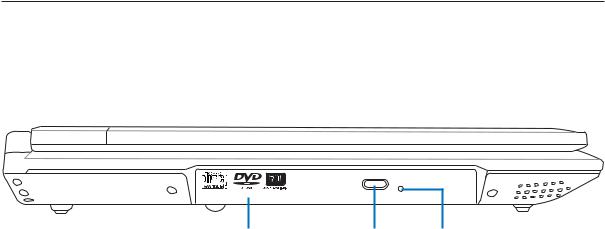
2 Knowing the Parts
Left Side
Refer to the diagram below to identify the components on this side of the Notebook PC.
Optical Drive |
Electronic |
Emergency |
(varies by model) |
Eject |
Eject |
 Optical Drive
Optical Drive
The Notebook PC comes in various models with different optical drives. The Notebook PC’s optical drive may support compact discs (CD) and/or digital video discs (DVD) and may have recordable (R) or re-writable (RW) capabilities. See the marketing specifications for details on each model.
 Electronic Eject, Emergency Eject
Electronic Eject, Emergency Eject
The optical drive eject has an electronic eject button for opening the tray. You can also eject the optical drive tray through any software player or by right clicking the optical drive in Windows™ “My Computer.” The emergency eject is used to eject the optical drive tray in case the electronic eject does not work. Do not use the emergency eject in place of the electronic eject. The activity LED (not available on some models) lights in proportion to the data transferred between the Notebook PC and optical disc.
22
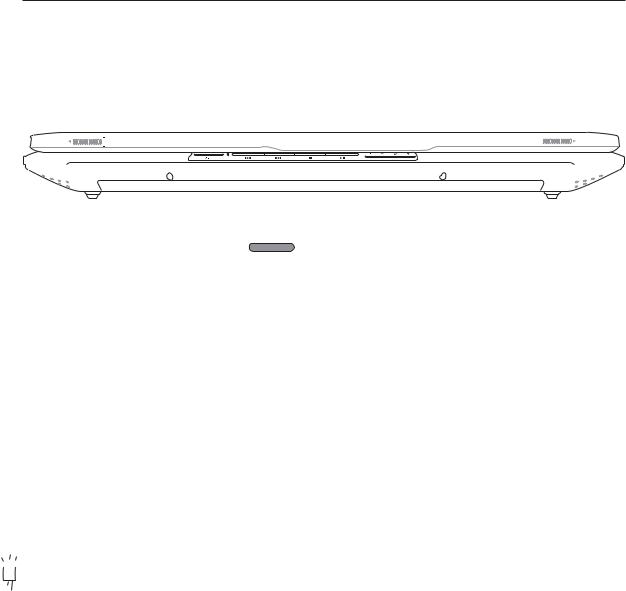
Knowing the Parts 2
Front Side
Refer to the diagram below to identify the components on the front side of the Notebook PC.
Display Panel Latch |
|
|
|
Display Panel Latch |
|
|
||||||||||
|
|
|
|
|
|
|
|
|
|
|
|
|
|
|
|
|
|
|
|
|
|
|
|
|
|
|
|
|
|
|
|
|
|
|
|
|
|
|
|
|
|
|
|
|
|
|
|
|
|
|
|
|
|
|
|
|
|
|
|
|
|
|
|
|
|
|
|
|
|
|
|
|
|
|
|
|
|
|
|
|
|
|
|
|
|
|
|
|
|
|
|
|
|
|
|
|
|
|
|
|
|
|
|
|
|
|
|
|
|
|
|
|
|
|
|
|
|
|
|
|
|
|
|
|
|
|
|
|
|
|
|
|
|
|
|
Audio Speaker |
CD Control Buttons |
Status Indicators |
Audio Speaker |
|
(see section 3) |
(see section 3) |
|
|
On selected models |
|
|
 Display Panel Latches
Display Panel Latches
Two spring-loaded latches on the front of the Notebook PC lock the display panel in the closed position when the Notebook PC is not in use. To open the display panel, slide both latches outwards with your thumbs and lift up the display panel with both thumbs. Slowly tilt the display panel forward or backward to a comfortable viewing angle.
 Audio Speakers
Audio Speakers
The built-in speaker allows you to hear audio without additional attachments. The multimedia sound system features an integrated digital audio controller that produces rich, vibrant sound (results improved with external stereo headphones or speakers). All audio features are software controlled.
 CD Control Buttons (on selected models)
CD Control Buttons (on selected models)
See Section 3 for details.
 Status Indicators
Status Indicators
See Section 3 for details..
23
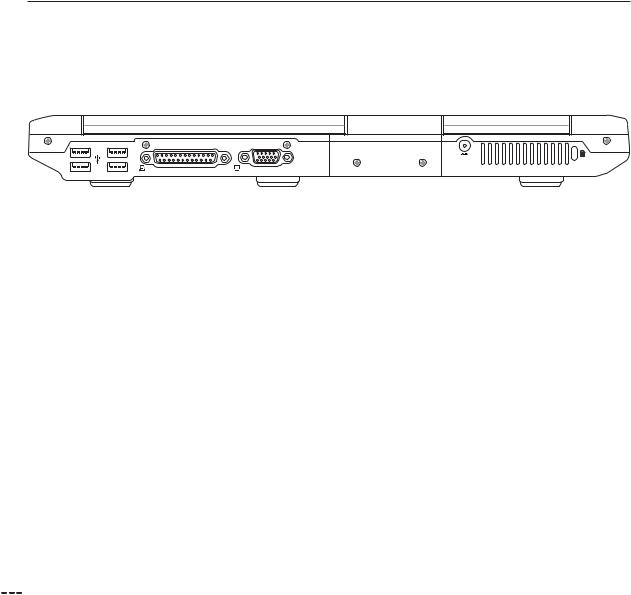
2 Knowing the Parts
Rear Side
Refer to the diagram below to identify the components on this side of the Notebook PC.
|
|
|
|
|
|
|
|
|
|
|
|
|
|
|
|
|
|
|
|
|
|
|
|
|
|
|
|
|
|
|
|
|
|
|
|
|
|
|
|
|
|
|
|
|
|
|
|
|
|
|
|
|
|
|
|
|
|
|
|
|
|
|
|
|
|
|
|
|
|
|
|
|
|
|
|
|
|
|
|
|
|
|
|
|
|
|
|
|
|
|
|
|
|
|
|
|
|
|
|
|
|
|
|
|
|
|
|
|
|
|
|
|
|
|
|
USB |
Parallel |
Display |
|||||||
|
|
|
Ports |
Port |
Output |
||||||||
|
|
|
|
|
|
|
|
|
|
|
|
|
|
|
|
|
|
|
|
|
|
|
|
Power |
Air Vents |
Kensington® |
|||
Input |
|
|
|
Lock Port |
|
 2.0 USB Port (2.0/1.1)
2.0 USB Port (2.0/1.1)
The Universal Serial Bus is compatible with USB 2.0 or USB 1.1 devices such as keyboards, pointing devices, video cameras, modems, hard disk drives, printers, monitors, and scanners connected in a series up to 12Mbits/sec (USB 1.1) and 480Mbits/sec (USB 2.0). USB allows many devices to run simultaneously on a single computer, with peripherals such as USB keyboards and some newer monitors acting as additional plug-in sites or hubs. USB supports hot-swapping of devices so that peripherals can be connected or disconnected without restarting the computer.
 Parallel Port
Parallel Port
The 25-pin D-sub parallel/printer port supports native parallel devices such as laser/inkjet printers, or parallel-adapted device such as external hard drives, removable drives, or scanners.
 Display (Monitor) Output
Display (Monitor) Output
The 15-pin D-sub monitor port supports a standard VGA-compatible device such as a monitor or projector to allow viewing on a larger external display.
 Power (DC) Input
Power (DC) Input
The supplied power adapter converts AC power to DC power for use with this jack. Power supplied through this jack supplies power to the Notebook PC and charges the internal battery pack. To prevent damage to the Notebook PC and battery pack, always use the supplied power adapter.
 Kensington® Lock Port
Kensington® Lock Port
The Kensington® lock port allows the Notebook PC to be secured using Kensington® compatible Notebook PC security products. These security products usually include a metal cable and lock that prevent the Notebook PC to be removed from a fixed object. Some security products may also include a motion detector to sound an alarm when moved.
24
